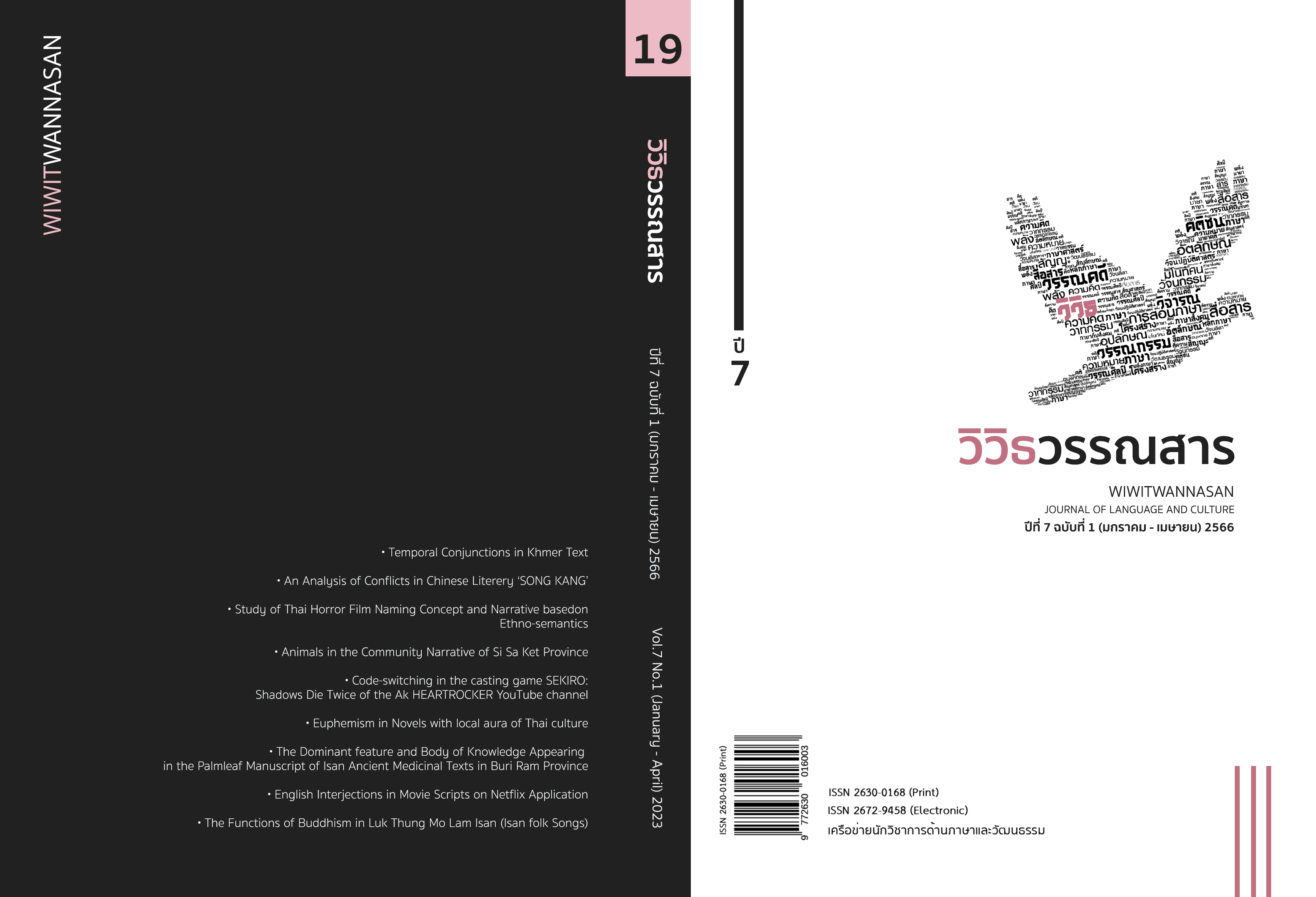บทบาทหน้าที่ของพระพุทธศาสนาในเพลงลูกทุ่งหมอลำอีสาน
Main Article Content
บทคัดย่อ
วัตถุประสงค์ของบทความวิจัยนี้ คือ เพื่อศึกษาบทบาทหน้าที่ของพระพุทธศาสนาที่ปรากฏในเพลงลุกทุ่งหมอลำอีสาน โดยศึกษาจากข้อมูลเพลงลูกทุ่งหมอลำอีสานจำนวน 132 เพลง จากโปรแกรมยูทูบระหว่างปี พ.ศ. 2550-2565 โดยใช้แนวคิดบทบาทหน้าที่ทางคติชนวิทยาและการตีความเชิงวัฒนธรรม การดำเนินการวิจัยศึกษาและวิเคราะห์ข้อมูลตัวบทเพลงที่มีเนื้อหากล่าวถึงพระพุทธศาสนา ผลการวิจัยพบว่า พระพุทธศาสนาได้รับการกล่าวถึงในเพลงลูกทุ่งหมอลำอีสาน 6 ลักษณะ ต่างกัน ดังนี้ พระพุทธเจ้า 2 เพลง พระธรรม 3 เพลง พระสงฆ์ 39 เพลง บุญพิธี-พุทธพิธีกรรม 46 เพลง พุทธสถาน 24 เพลง และ พุทธสัญลักษณ์ 17 เพลง เนื้อหาเพลงทั้งหมดแสดงความเคารพ สรรเสริญคุณ พร้อมทั้งขออำนวยพรให้เกิด สิริมงคล ขอให้พ้นจากความทุกข์ และความสุขสวัสดีแบบต่างๆ คำร้องขอที่พบมากคือขอให้มีสถานะทางการเงินดีขึ้น ดังนั้น พุทธศาสนาจึงมีบทบาทต่อการรังสรรค์เพลง เชื่อมโยงชาวอีสานที่อยู่ไกลบ้าน บทบาทหน้าที่ของพระพุทธศาสนาในเพลงลุกทุ่งหมอลำอีสานแสดงให้เห็นถึงความสัมพันธ์ของระบบความเชื่อที่มีบทบาทต่อวรรณกรรมเพลง เมื่อมีบทบาทเช่นนี้แล้วจึงทำให้เพลงดังกล่าวเป็นการใช้เสียงเชิงพิธีกรรม มีบทบาทหน้าที่ทำให้เพลงเช่นนี้เป็นความบันเทิงเชิงพิธีกรรมสำหรับปัดเป่าความทุกข์ทางใจ ให้ความบันเทิงขณะฟังพร้อมกับเสริมสร้างกำลังใจให้ผู้ฟังนั่นเอง
Article Details

อนุญาตภายใต้เงื่อนไข Creative Commons Attribution-NonCommercial-NoDerivatives 4.0 International License.
ลิขสิทธิ์ของบทความเป็นของวารสาร การพิมพ์ซ้ำจะต้องได้ร้บการอนุญาตจากบรรณาธิการวารสาร
เอกสารอ้างอิง
Ariyanuwat, Phra. (1970). Phaya Khan Khak [The King of toads]. Maha Sarakham: Northeastern Literature Conservation Center.
Bloomfield. M. (2000). Hymans of The Atharva-Veda. New Delhi: Motilal Banarsidass.
Dhammapidok, Phra. (2003). Photchananukrom Phut Sat Chabap Pramuan Sap [The
Buddhist dictionary Vocabulary edition]. 11th edition. Bangkok: Mahachulalongkornrajavidyalaya.
Engwanij, W. and Others. (2011). Watthanatham Pla Khong Chumchon Lumnam Chi [Fish culture of Chi River Basin community]. Bangkok: The Thailand Research Fund (TRF).
Gonda, J. (1989). Prayer and Blessing Ancient Indian Ritual Terminology. Leiden. Netherlands: E.J. Brill.
Lueangaramsree, P. (2003). Atta Lak Chattiphan Lae Khwam Pen Chai Khop [Identity, ethnicity, and marginalization]. In Atta Lak Chattiphan Lae Khwam Pen Chai Khop [Identity, ethnicity, and marginalization] (p. 15). Lueangaramsree, P.(editor.). Bangkok: Princess Maha Chakri Sirindhorn Anthropology Centre (Public Organization).
Ministry of Education. (1979). Nithan Rueang Pha Daeng Nang Ai Lae Prapheni Bun Bangfai [The tale of Pha Daeng Nang Ai and the Bun Bang Fai Tradition]. Bangkok: Teachers Council of Thailand Printing House Ladprao.
Nabangchang, S. (1983). Prawat Wannakhadi Bali Nai India Lae Langka [History of Pali Literature in India and SriLanka]. Bangkok: Chulalongkorn University.
Nathalang, S. (2009). Thruesadi Khati Chon Witthaya: Withi Witthaya Nai Kan Wikhro Tamnan Nithan Phuenban [Folklore theory: a mythological method of analyzing myths, folk tales]. Bangkok: Chulalongkorn University.
Padungjeewit, J. (1997). Kan Suesan Watthanatham Lae Atta Lak [Communication, Culture, and Identity]. Bangkok: Chulalongkorn University.
Palangwan, W. (2002). Lukthung Isan Prawattisat Isan Tamnan Phleng Lukthung [Isan Lukthung, Isan History, Legend of Lukthung]. Bangkok: Reunpanya.
Pitathawatchai, W. (1973). Hit Sip Song [The twelve annual Isan merit-making Traditions]. Bangkok: Mahachon.
Siam Rat Tepitakang. (1995). Siam Ratthasarajathaniyang [Tepitaka of Siam]. Bangkok: Mahamakutrajawittayalaya.
Siam Rat Tepitakatthakatha. (1992). Siam Ratthasarajathaniyang Mahamakutrajawittayalayena Pakasito [commentary of the Tepitaka of Siam was published by Mahamakut Buddhist University]. Bangkok: Mahamakutrajawittayalaya.
Somchai, S. Phramaha. (1995). Lak Tham Thang Phra Phut Sa Na Thi Prakot Nai Botphleng Luk Thung Thai [Buddhist Dharma Principles Appeared in Thai Luk Thung Songs]. Bangkok: Mahachulalongkornrajavidyalaya University.
Thitathan, S. (1990). Naeokhit Kiaokap Satsana Lae Khwamchuea Nai Sangkhom [Concepts of religions and beliefs in the society]. In Teaching materials regarding concepts of religions and beliefs in the society, unit 1-7. Nonthaburi: STOU Press.
Green, Th.A. (1997). An Encyclopedia of Beliefs, Customs, Tales, Music, and Art. California: Santa Barbara.
Yupo, Th. (1971). Tamnan Thet Ha Chat Lae Lae Rueang Len Mahachat [The legend of the Mahachat sermon and the varied versions of the Mahachat]. Printed as a memorial at the funeral of Mrs. Sathok Thanasarn (Sa-nga Wangnaitham). Phranakorn: Siwaporn.


